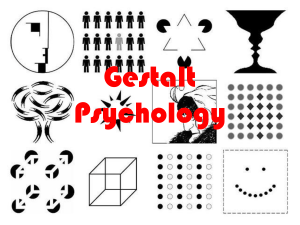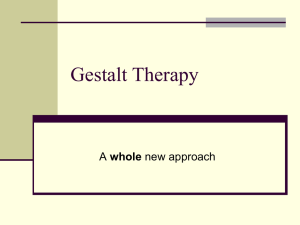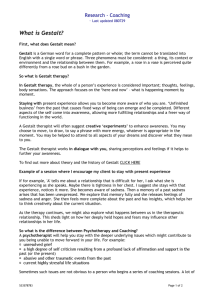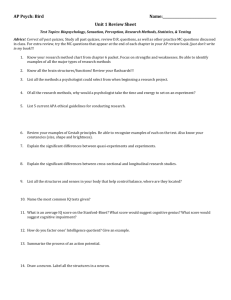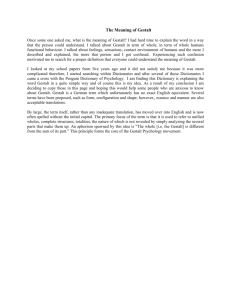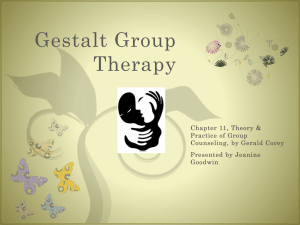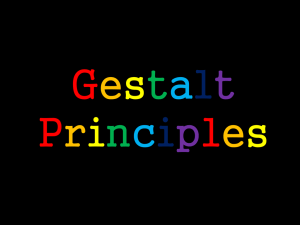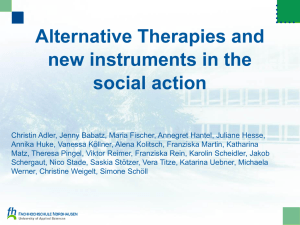Gestalt Therapy Frederick and Laura Perls
advertisement
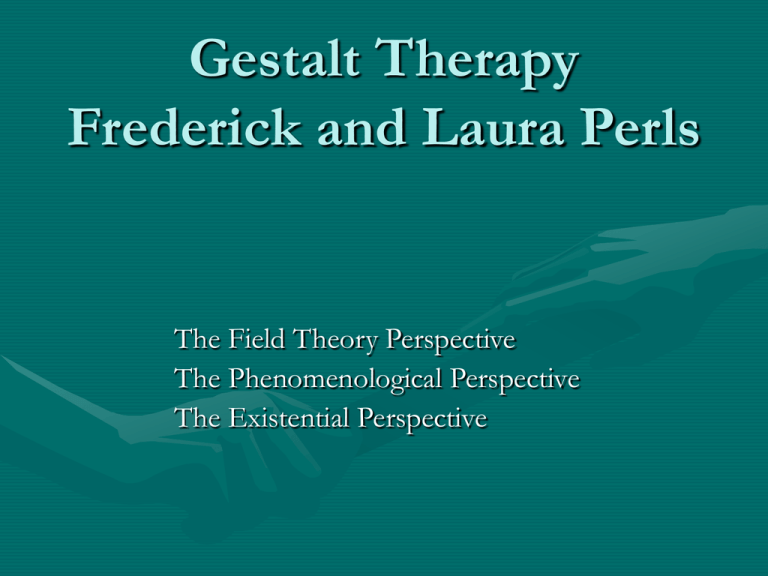
Gestalt Therapy Frederick and Laura Perls The Field Theory Perspective The Phenomenological Perspective The Existential Perspective Gestalt Personality Theory Concepts Gestalt psychology: • A psychological approach that studies the organization of experience into patterns or configurations. Gestalt psychologists believe that the whole is greater than the sum of its parts and study, among other issues, the relationship of a figure to its background. Gestalt Personality Theory Concepts • Ground: The background that contrasts with the figure in the perceptions of a field. • Figure: That part of a field that stands out in good contour clearly from the ground. The Field Theory Perspective • The field is a whole in which the parts are in immediate relationship and responsive to each other and no part is uninfluenced by what goes on elsewhere in the field. The field replaces the notion of discrete, isolated particles. • No action is at a distance: what has effect must touch that which is affected in time and space. • Work is in the here and now, with sensitivity to how the here and now includes residues of the past, such as body posture, habits, and beliefs. • The phenomenological field is defined by the observer and is meaningful only when one knows the frame of reference of the observer. The Phenomenological Perspective • A method of awareness, in which perceiving , feeling, and acting are distinguished from interpreting and reshuffling pre-existing attitudes. • Phenomenology is a discipline that helps people stand aside from their usual way of thinking so that they can tell the difference between what is actually being perceived and felt in the current situation and what is residue from the past (Idhe, 1977). The Existential Perspective • Existential phenomenologists focus on people’s existence, relations with each other, joys and suffering, etc., as directly experienced . • Most people operate in an unstated context of conventional thought that obscures or avoids acknowledging how the world is. • Self-deception is the basis of inauthenticity: living that is not based on the truth of oneself in the world leads to feelings of dread, guilt, and anxiety. Goal of Gestalt Therapy • By becoming aware, one becomes able to choose and/or organize one’s own existence in a meaningful manner. (Jacobs, 1978; Yontef, 1982, 1983). Gestalt Personality Theory Concepts • CONCERNS RELATED TO CONTACT • When there are disturbances in the contact boundaries, several difficulties result. Awareness of these disturbances is one focus of Gestalt therapy. Contact: – The relationship between "me" and others. Contact involves feeling a connection with others or the world outside oneself while maintaining separation from it. Levels of Contact (Neurosis) : The Polarity of Creating Adjustment • 1. The Phony layer: Reacting to others in unauthentic or patterned ways: every day, casual interaction or “small talk.” • 2. The Phobic layer: An avoidance of psychological pain. “I’m fine, I’m fine.” (Similar to Denial) Levels of Contact (Neurosis) The Polarity of Creating Adjustment • 3. Impasse: Is the point at which we are afraid to change or move. An impasse is a situation in which external support is not forthcoming and the person believes he cannot support himself. The individual attempts to manipulate the environment to do his seeing, hearing, thinking, feeling, and deciding for him. View of Health • An self-regulating person takes responsibility for what is done for self, what is done by others for self, and what is done for others by self. The person exchanges with the environment, but the basic support for regulation of one’s existence is by self. View of Mental illness • When the person does not know how to selfregulate, external support becomes a replacement for self-support rather than a source of nourishment for the self. • In Gestalt therapy, clients get through the impasse because of the emphasis on loving contact without doing the client’s work. (No rescuing/infantilizing) Levels of Contact (Neurosis) The Polarity of Creating Adjustment • 4. At the implosive level, the client may experience their feelings, start to become aware of the real self, but may do little about the feelings. • 5. Contact with the implosive level is authentic and without pretense. Contact boundaries: • The boundaries that distinguish between one person (or one aspect of a person) and an object, another person, or another aspect of oneself. Examples include body-boundaries, value-boundaries, familiarity-boundaries, and expressive-boundaries. CONTACT BOUNDARY DISTURBANCES • Introjection: This occurs when individuals accept information or values from others with our evaluating them or without assimilating them into one's personality. • Projection: When we ascribe aspects of ourselves to others, such as when we attribute some of our own unacceptable thoughts, feelings, or behaviors to friends, projection takes place. CONTACT BOUNDARY DISTURBANCES • Retroflection: When we do to ourselves what we want to do to someone else or do things for ourselves that we want others to do for us, then we experience retroflection. • Deflection: When individuals avoid meaningful contact by being indirect or vague rather that being direct, deflection occurs. CONTACT BOUNDARY DISTURBANCES • Confluence: When the separation between one's self and others becomes muted or unclear, we experience confluence. Thus, it can be difficult to distinguish what is one's own perception or values from those of another person. Awareness: • Attending to and observing what is happening in the present. Types of awareness include sensations and actions, feelings, wants, and values or assessments. Unfinished business: • Unexpressed feelings from the past that occur in the present and interfere with psychological functioning. They may include feelings, memories, or fantasies from earlier life (often childhood) that can be dealt with in the present. FOUR CHARACTERISTICS OF GESTALT DIALOGUE 1. Inclusion: This is putting oneself fully as possible into the experience of the other without judging, analyzing, or interpreting while simultaneously retaining a sense of one’s separate, autonomous presence. Inclusion provides as environment of safety for the client’s phenomenological work and, by communicating an understanding of the client’s experience, helps sharpen the client’s self-awareness. 2. Presence: • The Gestalt therapist expresses herself to the client. Regularly, judiciously, and with discrimination she expresses observations, feelings, personal experience, and thoughts, modeling phenomenological reporting. If the therapist relies on theory-derived interpretation, rather than personal presence, she leads the client into relying on phenomena not in his/her own immediate experience as the tool for raising awareness. 3. Commitment to Dialogue: • Contact is more than something two people do to each other. Contact is something that happens between people, something that arises from the interaction between them. This is allowing the contact to happen rather than manipulating, making contact, and controlling the outcome. 4. Dialogue is lived: • Dialogue is something done rather than talked about. “Lived” emphasizes the excitement and immediacy of doing. The mode of dialogue can be dancing, song, words, or any modality that expresses and moves the energy between or among participants, including the awareness of nonverbal expressions.
